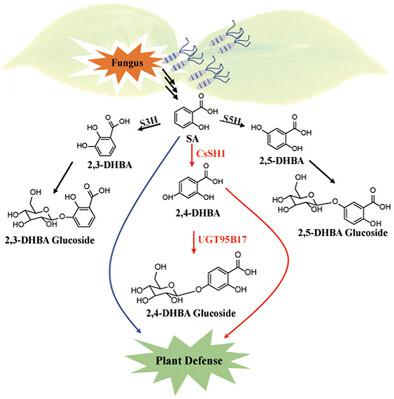Our official English website, www.x-mol.net, welcomes your
feedback! (Note: you will need to create a separate account there.)
2,4-Dihydroxybenzoic Acid, a Novel SA Derivative, Controls Plant Immunity via UGT95B17-Mediated Glucosylation: A Case Study in Camellia Sinensis
Advanced Science ( IF 14.3 ) Pub Date : 2023-12-08 , DOI: 10.1002/advs.202307051 Mengqian Lu 1 , Yifan Zhao 1 , Yingying Feng 1 , Xiaoyan Tang 1 , Wei Zhao 1 , Keke Yu 1 , Yuting Pan 1 , Qiang Wang 1 , Jilai Cui 1, 2 , Mengting Zhang 1 , Jieyang Jin 1 , Jingming Wang 1 , Mingyue Zhao 1 , Wilfried Schwab 1, 3 , Chuankui Song 1
Advanced Science ( IF 14.3 ) Pub Date : 2023-12-08 , DOI: 10.1002/advs.202307051 Mengqian Lu 1 , Yifan Zhao 1 , Yingying Feng 1 , Xiaoyan Tang 1 , Wei Zhao 1 , Keke Yu 1 , Yuting Pan 1 , Qiang Wang 1 , Jilai Cui 1, 2 , Mengting Zhang 1 , Jieyang Jin 1 , Jingming Wang 1 , Mingyue Zhao 1 , Wilfried Schwab 1, 3 , Chuankui Song 1
Affiliation

|
The plant hormone salicylic acid (SA) plays critical roles in plant innate immunity. Several SA derivatives and associated modification are identified, whereas the range and modes of action of SA-related metabolites remain elusive. Here, the study discovered 2,4-dihydroxybenzoic acid (2,4-DHBA) and its glycosylated form as native SA derivatives in plants whose accumulation is largely induced by SA application and Ps. camelliae-sinensis (Pcs) infection. CsSH1, a 4/5-hydroxylase, catalyzes the hydroxylation of SA to 2,4-DHBA, and UDP-glucosyltransferase UGT95B17 catalyzes the formation of 2,4-DHBA glucoside. Down-regulation reduced the accumulation of 2,4-DHBA glucosides and enhanced the sensitivity of tea plants to Pcs. Conversely, overexpression of UGT95B17 increased plant disease resistance. The exogenous application of 2,4-DHBA and 2,5-DHBA, as well as the accumulation of DHBA and plant resistance comparison, indicate that 2,4-DHBA functions as a potentially bioactive molecule and is stored mainly as a glucose conjugate in tea plants, differs from the mechanism described in Arabidopsis. When 2,4-DHBA is applied exogenously, UGT95B17-silenced tea plants accumulated more 2,4-DHBA than SA and showed induced resistance to Pcs infection. These results indicate that 2,4-DHBA glucosylation positively regulates disease resistance and highlight the role of 2,4-DHBA as potentially bioactive molecule in the establishment of basal resistance in tea plants.
中文翻译:

2,4-二羟基苯甲酸,一种新型 SA 衍生物,通过 UGT95B17 介导的糖基化控制植物免疫:以茶树为例
植物激素水杨酸(SA)在植物先天免疫中发挥着关键作用。几种 SA 衍生物和相关修饰已被鉴定,但 SA 相关代谢物的作用范围和作用模式仍然难以捉摸。在此,研究发现 2,4-二羟基苯甲酸 (2,4-DHBA) 及其糖基化形式是植物中天然的 SA 衍生物,其积累主要是由 SA 施用和Ps诱导的。茶树( PCs ) 感染。 CsSH1(一种 4/5-羟化酶)催化 SA 羟基化为 2,4-DHBA,UDP-葡萄糖基转移酶 UGT95B17 催化 2,4-DHBA 葡萄糖苷的形成。下调可减少2,4-DHBA葡萄糖苷的积累,增强茶树对PCs的敏感性。相反, UGT95B17的过度表达增加了植物的抗病性。 2,4-DHBA和2,5-DHBA的外源施用,以及DHBA的积累和植物抗性比较,表明2,4-DHBA作为潜在的生物活性分子,主要以葡萄糖结合物的形式储存在植物体内。茶植物中,与拟南芥中描述的机制不同。当外源施用2,4-DHBA时, UGT95B17沉默的茶树比SA积累更多的2,4-DHBA并表现出诱导的对Pcs感染的抗性。这些结果表明,2,4-DHBA 糖基化可积极调节抗病性,并强调 2,4-DHBA 作为潜在生物活性分子在茶树基础抗性建立中的作用。
更新日期:2023-12-08
中文翻译:

2,4-二羟基苯甲酸,一种新型 SA 衍生物,通过 UGT95B17 介导的糖基化控制植物免疫:以茶树为例
植物激素水杨酸(SA)在植物先天免疫中发挥着关键作用。几种 SA 衍生物和相关修饰已被鉴定,但 SA 相关代谢物的作用范围和作用模式仍然难以捉摸。在此,研究发现 2,4-二羟基苯甲酸 (2,4-DHBA) 及其糖基化形式是植物中天然的 SA 衍生物,其积累主要是由 SA 施用和Ps诱导的。茶树( PCs ) 感染。 CsSH1(一种 4/5-羟化酶)催化 SA 羟基化为 2,4-DHBA,UDP-葡萄糖基转移酶 UGT95B17 催化 2,4-DHBA 葡萄糖苷的形成。下调可减少2,4-DHBA葡萄糖苷的积累,增强茶树对PCs的敏感性。相反, UGT95B17的过度表达增加了植物的抗病性。 2,4-DHBA和2,5-DHBA的外源施用,以及DHBA的积累和植物抗性比较,表明2,4-DHBA作为潜在的生物活性分子,主要以葡萄糖结合物的形式储存在植物体内。茶植物中,与拟南芥中描述的机制不同。当外源施用2,4-DHBA时, UGT95B17沉默的茶树比SA积累更多的2,4-DHBA并表现出诱导的对Pcs感染的抗性。这些结果表明,2,4-DHBA 糖基化可积极调节抗病性,并强调 2,4-DHBA 作为潜在生物活性分子在茶树基础抗性建立中的作用。































 京公网安备 11010802027423号
京公网安备 11010802027423号